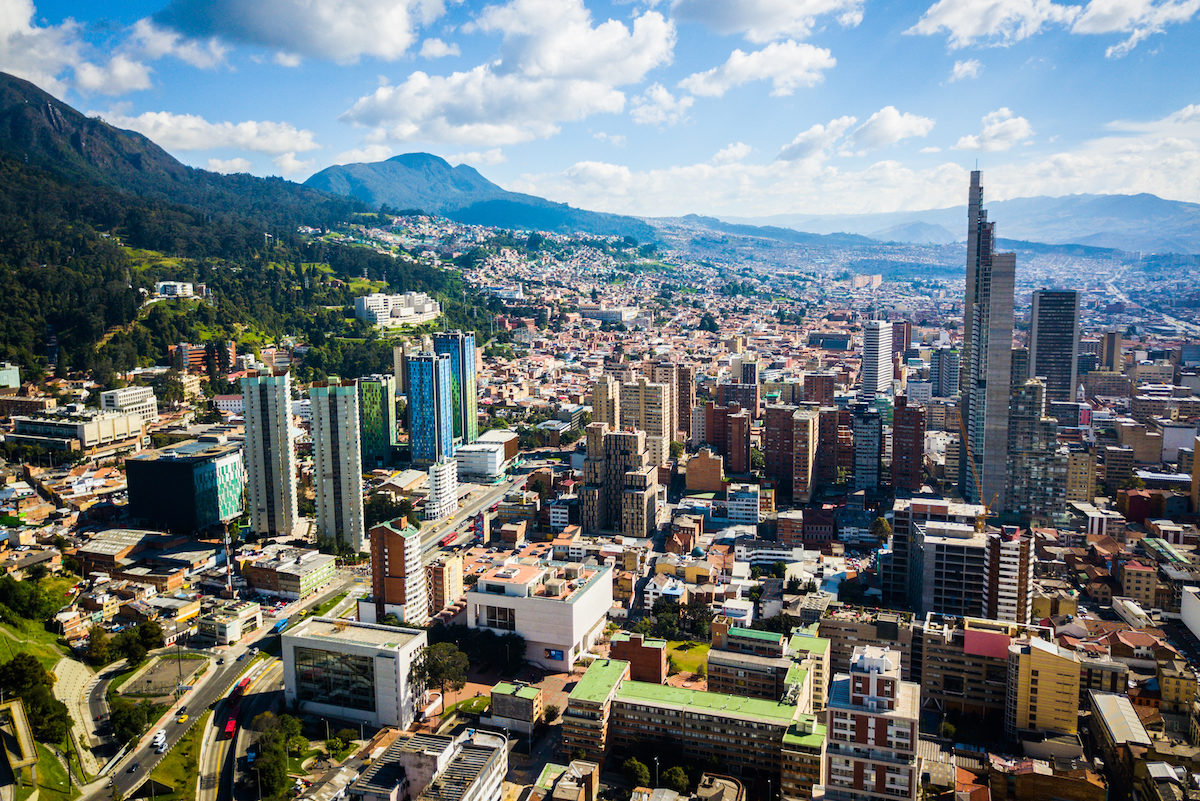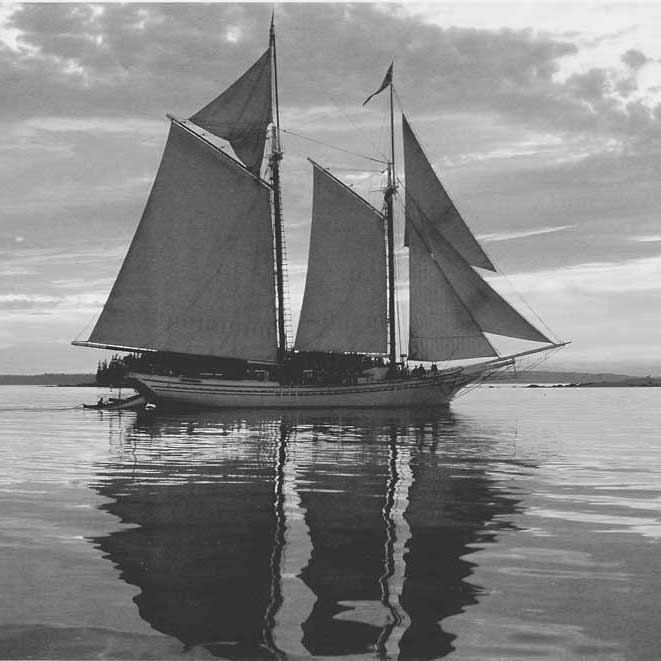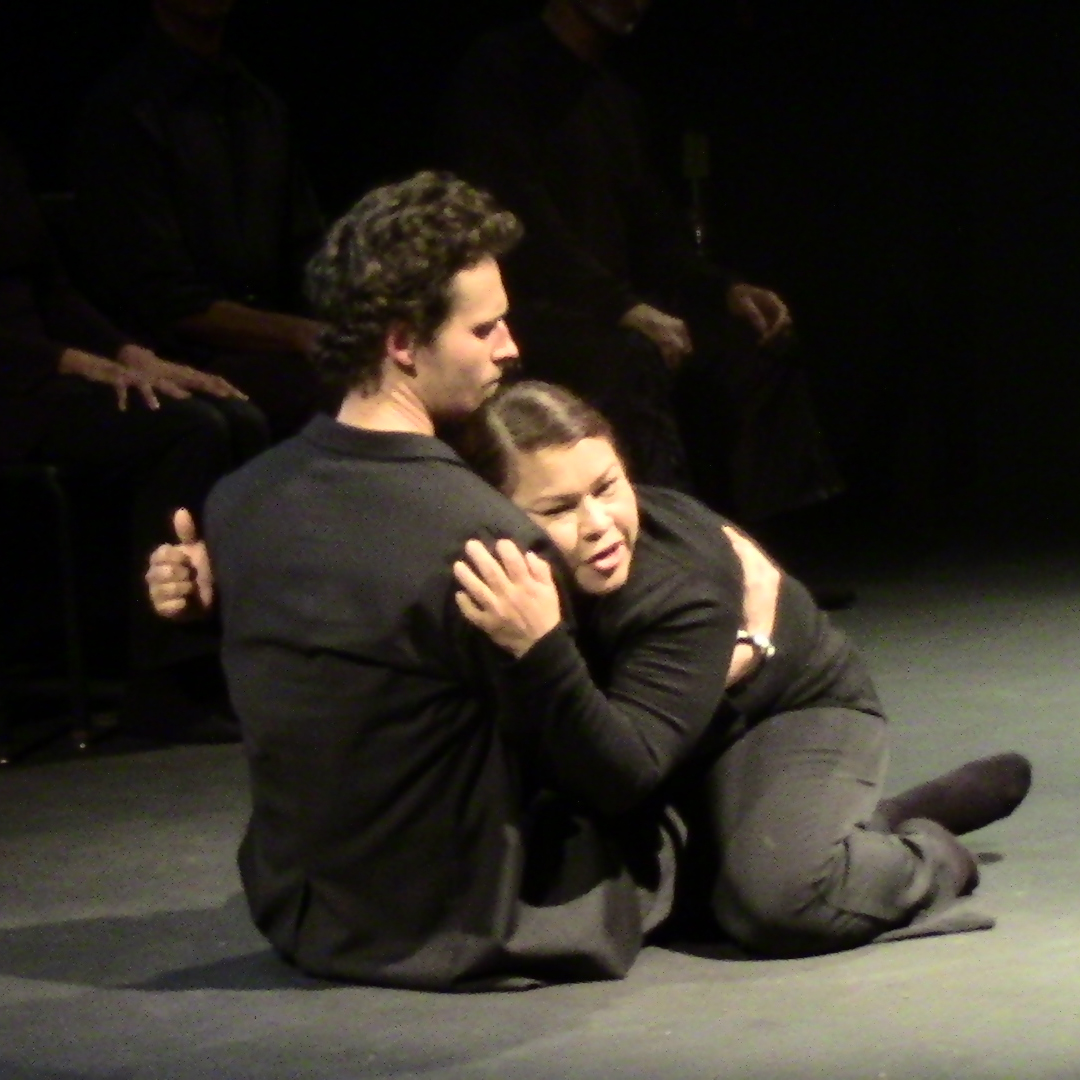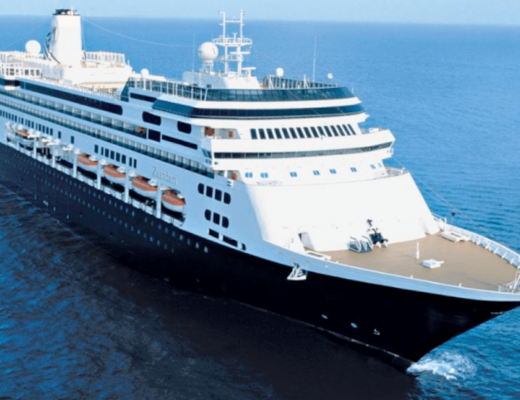Only a three and a half hour plane ride from Fort Lauderdale exists a bustling urban metropolis at the base of a picturesque green mountain. At more than 8,000 feet in elevation, this city sits high. Its historic urban center feels European — small alleys, Spanish colonial architecture, open air markets with artisans and vendors selling unique fruits, colorful beaded jewelry and handmade bags. In one square you meander past a grand Spanish-style Catholic Cathedral with roots dating back to the 1500s. This square is rich with intriguing tales of drama and history. From the edges of the square you peer up the steep stone streets to see the mountaintop towering overhead. You pace a few blocks to another square with an emerald market where men and women swarm to show you their emeralds, folded in tiny pieces of paper and priced to sell. Or, you can take the less risky route and visit one of the more expensive, government-certified shops to assure the authenticity of your purchase. As you observe the busy square your nose is captured by the strong aroma of freshly roasted coffee, brewed on a little yellow cart, and your eyes admire one of the many graffiti murals this city has to offer.
If you’re still not sure where I’m talking about, then you should discover the wonders of Bogotá for yourself. Though decades of conflict earned Colombia a bad name for a prolonged time, the country has worked tediously to reinvent itself and open its arms wide to tourists. Our group of Lighthouse Point-based travelers were blown away by Bogotá’s culture, history, culinary offerings, museums, art and hospitality. Together we spent four days and three nights in Bogotá, discovering the city’s rich array of offerings.
La Candelaria
We started our first day early on a Thursday, our first destination La Candelaria, the vibrant, historic heart of Bogotá. We ventured to Bolívar Square, home to both the Metropolitan Cathedral Basilica of the Immaculate Conception and the Palace of Justice of Colombia.
The Palace of Justice stands peaceful now — children giggling outside as they feed flocks of pigeons from their ticklish hands — but the building also casts a metaphorical shadow, a reminder of Colombia’s troubled past. The Palace was the scene of a famous November 1985 siege when the President of the Supreme Court and five other judges, among four dozen bystanders and government workers ,were killed by M-19, the country’s then main urban guerrilla group.
Our knowledgable guide re-counted this dramatic tale: The M-19 guerrillas reportedly took 300 hostages and burnt criminal records containing proof and warrants against members of their group. It is also believed, but not proven, that the group burnt records against Pablo Escobar, one of the nation’s biggest drug traffickers at the time. Using armored cars and automatic weapons, the National Army of Colombia took the building back by force, destroying much of its exterior. The building was re-built and now holds the Supreme Court of Justice, the Constitutional Court, the State Council and the Supreme Judicial Council.
After visiting the Palace of Justice, we wandered the square as our guide shared other stories of Bogotá dating back to Simon Bolivar, after whom the square was named. Historic tales apparently build up an appetite; once our group was finished with the Plaza they were willing to try just about anything for lunch, including Capybara.
“Capy-what?” you ask. Capybara — a rodent that looks much like a giant guinea pig, with a cute boxy nose and beaver-brown fur. While we all tried to mimic the culinary courage of Anthony Bourdain, each tasting a small sample of the Capybara meat, grilled over an open flame and served on a toothpick, only one brave soul ordered the charred rodent for lunch. The rest of us tried a quintessential Colombian Ajiaco, a hearty soup with chicken, corn and potato.
Emeralds & Gold, Oh My
With bellies full, we set out in search of emeralds. Colombian emeralds, famous for their exotic beauty, account for 70 to 90 precept of the world’s emerald market and are said to be among the purest emeralds in the world. They can range anywhere between $30 and $10,000 based on the quality and age of the stone. Younger emerald formations are more opaque and light in color, while those worth thousands formed approximately 40 million years ago and are translucent and dark green.
The Plazoleta del Rosario (Rosary Plaza) is surrounded by cheaper emerald peddlers, while a government-certified shop around the corner sells them at a much higher price. On the edge of the Plaza is also the Museum del Oro, or Gold Museum. Inside one will find multiple floors of gold artifacts and learn about Colombia’s indigenous tribes. Eighty-two indigenous tribes still live in different zones of Colombia, speaking different native languages, far-removed from modern civilization. Our guide recounted stories of Spanish conquistadors who wiped out tribes for their gold, and of Colombia’s Lost City — a city older than Machu Picchu located high in the mountains of Sierra Nevada de Santa Marta where people of the indigenous Tairona Tribe still reside.
One room in the Gold Museum recounts the legend of Lake Guatavita, one of the sacred lakes of an ancient tribe called Muisca. For approximately 500 years the Musica would conduct two ceremonies a year on the Equinox and Solstice during which the zipa, the leader of the tribe, would cover himself in gold dust and take a raft to the center of the lake. After diving into its waters, worshippers would throw trinkets, jewelry and other precious offerings into the lake. Approximately 1,800 gold artifacts supposedly recovered from the lake are on display in a circular room of the museum, which feels ethereal.
After a long first day in Bogotá, our group was ready for a little rest before dinner. We dodged the rain (fair warning: Bogotá is known for periodic, but frequent rain storms — always, I repeat always, carry an umbrella) and piled back into our tour bus to take the mountainous drive to our accommodations.
We arrived at the W Hotel, where we were greeted with cucumber water and hot towels. The W in Bogotá is an uber-modern, semi-funky, yet stylishly-chic hotel with first-rate hospitality, urban views and a peaceful spa. [Read about where we stayed below.]
The Coffee Professor
On day two of our Colombian adventure, our group met up with Karen Attman at Amor Perfecto Café, a Colombian specialty coffee shop and roaster located in the Usaquén district of Bogotá. Attman is a Bogotá-based, American writer whose love of food and coffee led her to start Flavors of Bogotá, a food magazine dedicated to discovering the best of Colombian cuisine. She later developed “Flavors of Bogotá Specialty Coffee Experiences” in 2015 — an educational tour that teaches foreigners and locals alike about specialty coffee. She is the author of “Permission to Slurp,” which was nominated for the category of Best Coffee Books by the Gourmand Awards in 2018, and teaches coffee courses for a university, making her a “coffee professor.”
While Attman had lived in Latin America for 22 years before moving to Colombia, it wasn’t until she moved to Bogotá about six years ago that she developed a deep fascination with coffee.
“What I discovered was that there is this really cool coffee scene that a lot of people don’t know about and is a little bit hidden. It’s very alive and healthy here in Colombia. I said ‘people have to know about this,’” she said. “But it’s really hard to discover whether you come for a short visit, or even a longer one. People have been coming to these coffee shops for years and they still don’t know what’s behind it.”
Attman, the coffee professor, gathered us around a long table in a beautiful sun room in the back of Amor Perfecto Café where she taught us about the process of growing and harvesting coffee, the science of proper roasting, techniques for brewing and cupping, and coffee’s overall significance to Colombia’s post-conflict renewal. Coffee, she said, in addition to cacao, have played a substantial role in replacing illicit crops.
After Amor Perfecto Café, Attman guided us on a walking tour to two other specialty coffee shops, including Cafe San Alberto and Catación Pública. At Catación Pública we were privileged to see a working coffee roasting lab — what looks like a science lab, replete with beakers and scales and safety goggles, where a young woman tested a batch of beans with the utmost care. Attman explained that the coffee tester was assessing the bean’s quality, how best to roast the coffee and what temperature water to brew the coffee at to achieve perfection. The lab, she said, is completely enclosed and off-limits to outsiders because coffee easily absorbs the flavors of other influences like perfume or food.
At Catación Pública we also got to sample coffee cherries. As we had learned earlier on the tour, coffee is actually from inside a berry — one red in color and slightly juicy. The pit of the cherry is the bean used to make coffee. The whole cherry, however, is quite tasty. The barista brought out a few small bowls of what looked like cherry-pie-filling but was actually coffee cherries in a sweet syrup made by soaking the cherries. The coffee bean inside gave each bite a satisfying crunch while the berry itself was delectably sweet.
Following our tour with Attman, our group walked a few blocks over to La Mar, a Peruvian inspired seafood restaurant that wowed all of us. [Read more about our dining adventures below.]
The Bull Ring, Botero Museum & Mount Monserrate
On our third day in the city, we took a private bus tour to some key attractions of Bogotá. The first stop was Plaza de Toros Santamaría, the Santamaría Bullring. The stadium was built in 1931 and has served as a world destination for Spanish-style bull fighting. In recent years the bullring shifted its focus to host live music and cultural arts events. Bogotá’s last mayor, Gustavo Petro, had put an end to the traditional functions of the Bogotá bullring, saying he believed the space should be used for “activities for life, not death.” His successor, Enrique Peñalosa, also declared himself against the sport, but when the constitutional court ruled that the ban was an infringement on bullfighters’ right to expression, bullfighting returned.
Massive, and sometimes violent, protests followed. Opposition sees the sport as entirely barbaric and cruel, while supporters see it as a central part of Colombia’s Spanish cultural heritage. The fights are generally completed upon the death of one bull, which is then hung from a steel chain over a grate in the floor to drain its blood. The meat is donated and consumed.
While the bullring is not traditionally open to tourists, a security guard on site graciously took us inside to have a look around. He showed us the bullpens, a small chapel where bullfighters go to pray before a fight and a surgeon’s quarters where matadors can be treated if they incur injuries during the fight.
Our second stop was the Botero Museum in the Candalaria district. Fernando Botero Angulo is a world-renowned Colombian figurative artist and sculptor. He is best known for his ability to play with proportions of the human body. Some of his work — almost cartoonish in nature — portrays chunky bodies with ballooned body parts. The museum also features Botero sculptures and the works of other famous artists including Salvador Dali, Pablo Picasso, Claude Monet and Henri Matisse, which were donated to the museum from Botero’s personal collection.
The last stop, and probably most remarkable of the day, was Mount Monserrate, the highest point in Bogotá with an elevation of 10,341 feet above sea level. The hill was a sacred mountain to the pre-Colombian natives and is currently a pilgrimage site for Catholics, some of whom climb the mountain on their knees.
As tourists, however, the mountain can be traversed by aerial tramway, a funicular or by walking. The top of the mountain offers spectacular views of Bogotá below, while the Monserrate Catholic Sanctuary is a serene getaway to take a stroll. A small outdoor marketplace sells souvenirs, coca tea, coffee and other artisan wares. Multiple restaurants with panoramic views are picturesque places to dine. Our group opted to try Restaurante Casa San Isidro, a fine-dining French restaurant with classic dishes like Chateaubriand. [Read more about our dining adventures below.]
The Ciclovía & Usaquén Market
Our last day in Bogotá was the day of The Ciclovía — a fascinating weekly event in Bogotá from 7am to 2pm on Sundays and holidays when most major streets (approximately 76 miles of them) shut down to automotive traffic and allow only cyclists, runners and walkers. The Ciclovía program has been government run since 1974 and some 1.7 million people (about a quarter of the city’s population) turn out for it on average every week.
Sundays is also the day when local street markets are bustling. Thus was the case in Usaquén where our group meandered the Mercado de las Pulgas de Usaquen — about three miles worth of street vendors selling handmade artisan products, clothing, cookware, hats and artwork. Street performers and live music create a festive environment, while the cobblestone streets and abundant locals give the market inviting charm. Our group of travelers reveled at the absence of American-style influences at the market. Banks, newspapers, fitness clubs and other businesses are not found selling their services at this market as the variety of authentic, artisan vendors is strictly monitored, we were informed.
WHERE WE DINED
Tábula
Featured on Anthony Bourdain’s Parts Unknown, Tábula has gained some international notoriety. It is easy to see why. Both the environment and food inspire conversation and camaraderie. The intimate, garden-style dining room is lined with lush plants and features a wood-burning oven in the center. The dishes are served family-style at long wooden tables where guests share bottles of wine and pass small cast-iron skillets full of moist meats, charred vegetables, fresh salads from the garden and homemade desserts. Our group tried several tasty meat dishes including Oxtail and braised beef, but our favorite dish of the night was a light and creamy banana panna cotta with puffed crunchy corn and a thin Carmel sauce, served of course, with a freshly roasted cup of Colombian coffee.
La Mar Cebichería Peruna
This modern Peruvian seafood restaurant featured multiple styles of ceviche, homemade corn cakes topped with fresh seafood and decadent sauces, unique sushi rolls and arroz con mariscos, a Peruvian-style paella served in a cast iron pot. Floor-to-ceiling glass windows at the front of the dining room let in nice natural light and offered refreshing views of greenery, while high lofted ceilings and wood paneled walls crafted a chic and trendy environment. A glass seafood counter displayed the restaurants fresh catches and the bar pumped out dozens of Pisco sours. The corn cakes, in multiple varieties, are a must-try.
Abasto
Abasto feels like a country-style, farm-to-table Colombian restaurant. We dined in a private back room around a large table surrounded by shelves of local products — honey, flower, fruits, spices and eggs. Fresh baked goods adorned a counter next to a display case of local meats and cheeses.
Our dinner companions were two of Bogotá’s best dining review writers who had selected the restaurants for our days in Bogotá. Their life-long knowledge of dining in the city added immeasurably to our enjoyment of the traditional Colombian dishes featuring unique spices and some refreshing cocktails made with local fruits.
Andres Carnes De Rez
No visit to Bogotá is complete without an evening at Andres Carnes De Rez or it’s sister restaurant Andres DC in downtown Bogotá. Both are huge, loud and fun. They are places that appeal to tourists and locals – especially on weekend nights. The food is traditional Colombian. The cocktails are delightfully obnoxious, and be prepared to dance – on the dance floor, around your table, or on your table. This is a kind of place where that happens, and it did for us.
El Bandito Bistro
This place makes one feel as if they’ve teleported to a hipster bar in New York City. Curled mustaches, high fashion, live 20s-era jazz, old-fashioned Manhattans and top-shelf scotch. The place was packed with young, classy, too-cool-for-school hipster types out for the evening. The food
Asadero
This was the hole-in-the-wall home in the La Candalria district to the infamous Capybara, a large rodent (that looks like a giant guinea pig) grilled over an open flame. We also recommend the quintessential Colombian Ajiaco, a hearty soup with chicken, corn and potato.
Where we stayed: The W Bogotá Hotel
Like other large cities, the location of your hotel can be a difficult choice. One option can be close to a few things, but an hour or two from other desired locations. At first, the driving times seemed long and traffic in Bogotá can be brutal, but after a few days, the group agreed the location was the best.
More traditional hotel options are available such as Hotel de la Opera. The group enjoyed the very modern and luxurious W Bogotá and enjoyed the charm and traditions of Colombia in other ways.
Our morning routine of meeting in the hotel restaurant was perfect. There was no easier option and the food was very Colombian.
FEAT Beauty of Bogota Pompano Magazine






